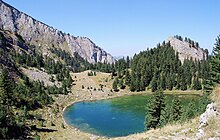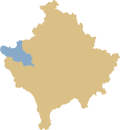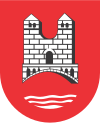Peja
|
Pejë / Peja 1 Peć / Пећ 2 |
||||
|
||||
| Basic data | ||||
|---|---|---|---|---|
| State : |
|
|||
| District : | Peja | |||
| Municipality : | Peja | |||
| Coordinates : | 42 ° 40 ′ N , 20 ° 18 ′ E | |||
| Height : | 505-520 m above sea level A. | |||
| Residents : | 48,962 (2011) | |||
| Telephone code : | +383 (0) 39 | |||
| Postal code : | 30000 | |||
| License plate : | 03 | |||
|
1 Albanian (indefinite / definite form) , 2 Serbian (Latin / Cyrillic spelling) 3 Kosovo's independence is controversial. Serbia continues to regard the country as a Serbian province. |
||||

Peja ( Albanian also Pejë , Serbian Пећ Peć ) is a city in western Kosovo . With almost 49,000 inhabitants, it is the fourth largest in the country and the headquarters of the community named after it, with around 96,000 inhabitants . In addition, Peja is the seat of the Peja district .
geography
location
The city is located ten kilometers east of the border with Montenegro and approximately as far northeast of the border with Albania . Peja is located on the Bistrica e Pejës river . The White Drin , the largest river in Kosovo, rises not far from the city in the mountainous regions on the way to the Montenegrin border.
climate
Peja has a continental climate . The summers are usually very warm and low in precipitation, the winters cold and rich in precipitation. The average annual rainfall is around 850 mm.
|
Average monthly temperatures and rainfall for Peja
Source: www.weatherbase.com
|
||||||||||||||||||||||||||||||||||||||||||||||||||||||||||||||||||||||||||||||||||||||||||||||||||||||||||||||||||||||||||||||||||||||||||||||||||||||
history
The city's roots go back to antiquity . During the Roman times the place was called Picaria . The names in today's languages are probably also derived from this name ( Peja and Peć ). Another explanation for the naming by the many caves in the Prokletije - Mountains and Northern Albanian Alps, looming up on the south end of town. Peć is said to have resulted from the Serbian word pećina for cave .
In 1253 Peja took over as the seat of the Serbian Orthodox Archbishops of Žiča as a result of the southern expansion and relocation of the Serbian sphere of influence . 1346 raised Stefan Uroš IV. Dušan Peć to the rank of patriarchate . Even after the Ottomans had gradually conquered the Serbian Empire after the battle on the Amselfeld in 1389, Peć remained the seat of the Serbian Orthodox Church until 1463 . During the Ottoman period (until 1912) the city was named Ipek and was the seat of a sanjak .
The patriarchy was restored in 1557. This was achieved by Sokollu Mehmed Pascha , Grand Vizier of Sultan Suleyman I and brother of the new Serbian Patriarch Makarije (Latin: Macarius ). In 1766, the Turks subordinated the Serbian patriarchate to the Patriarchate of Constantinople after bloody clashes with the Serbian population had previously occurred, which had also led to a huge wave of Serbs emigrating from Kosovo to Vojvodina . The Serbian Patriarchate was not reestablished until 1920 in Belgrade .
During the Ottoman period (until 1912) the city was named İpek and was the seat of a sanjak in Vilayet Kosovo . For the 19th century, Meyers Konversations-Lexikon records around 7000 inhabitants, mostly Greek and Mohammedan Serbs, and the main branches of industry are fruit, tobacco and mulberry planting and silk making . In 1899, representatives of leading conservative Islamic Albanian families in the city formed the "League of Peja". The city belongs to the part of southeast Europe that has been under Ottoman rule the longest. Only after the First Balkan War in 1912/13 did the Turks withdraw and Peć became part of the Kingdom of Montenegro , while the rest of today's Kosovo was annexed to the Kingdom of Serbia . At the end of 1918 Peć became part of the Kingdom of Serbs, Croats and Slovenes (from 1929 Kingdom of Yugoslavia ) after Montenegro joined Serbia and after its unification with the southern Slavic regions of Austria-Hungary . It was only in the federal system of socialist Yugoslavia from 1945 that Peć came to the newly created Socialist Republic of Serbia as part of the province of Kosovo and Metohija . During this time the city was the seat of a Serbian administrative district.
Since 2008 Peja has been part of the newly established Republic of Kosovo, which is currently recognized by 114 states.
population
In the 2011 census, the city of Peja was registered as having a population of 48,962. Of these, 45,915 (93.78%) are Albanians , 1438 (3.03%) Roma , Ashkali and Balkan Egyptians , 1178 (2.41%) Bosniaks , 174 (0.36%) Gorans , 46 Turks and 21 Serbs .
| census | 1948 | 1953 | 1961 | 1971 | 1981 | 1991 | 2011 |
|---|---|---|---|---|---|---|---|
| Residents | 17,277 | 21,058 | 28,351 | 41,853 | 54,497 | 68.163 | 48,962 |
With the large proportion of emigrants in the population living in Western and Central Europe and the United States , 29.3 percent of homes are vacant. In 2011, an average of five to six people lived in one household. The population density was 158.8 people / km², which was below the national average (175 people / km²).
Albanians , Bosniaks , Kosovar Egyptians and Roma count themselves to be Islam . The Albanian Muslims organize themselves in the Islamic Community of Kosovo (alb. Bashkësia Islame e Kosovës ). A minority of Albanians are Catholics who settle in the city itself and in the villages of Gllaviçica / Glavičica, Gllogjan / Glođane, Nepolë / Nepolje, Llugagji, Dugajve and Potërq / Petrić. The Catholics are administered by the Prizren-Pristina diocese (alb. Ipeshkvia e Kosovës ) in Prizren , which is directly subordinate to the Holy See . Most of the Serbs belong to the Serbian Orthodox Church .
administration
The institutions of the municipality of Peja, which are all located in the city, are responsible for the administration.
Culture and sights

Peja is located in a varied landscape and is home to the patriarchal monastery, which is probably the most important building for the Serbian Orthodox Christians. The Serbian Orthodox Visoki Dečani monastery is also located about 15 kilometers south of the city . Both monasteries are since 2004 the UNESCO - World Heritage Site .
Buildings
Red mosque
The Red Mosque owes its name to its red bricks, which make it unique for the region. According to an inscription above the entrance, it was renovated in 1173 AH Islamic calendar (1759–1769) and 1307 AH Islamic calendar (1889–1890). The building is now a burned-out ruin, parts of the facade, the marble minbar and mihrāb and the minaret are still preserved . The UNESCO has recommended the restoration of the building.
Kurshumli Mosque (Lead Mosque)
Named for its leaden roof covering, the mosque was destroyed and restored several times. In Yugoslav times it served as an ammunition depot, since 1965 it has been used again as a prayer house by the surrounding Muslim communities. It was burned down in May 1999 and later restored.
The prayer house is twelve by twelve meters and was originally roofed by a wooden domed vault covered with lead on the outside. The walls are made of quarry stone and covered with white plaster. The prayer niche is still recognizable. The original minaret was replaced in 1989 by a new building of no historical value. The UNESCO has recommended the restoration of the building.
Bajrakli Mosque (Standard Bearer Mosque)
The building, also called Al-Fatih Mosque, was built by Sultan Mehmed II at the end of the 15th century . After it was burned down in June 1999, it was restored with Italian donations. The Bayrakli Mosque consists of a portico and the prayer room, which is richly decorated with ornamental paintings. The minaret probably belongs to an earlier mosque. The building is considered an example of Ottoman architecture in Europe .
Church of St. Catherine
The Church of St. Catherine is the spiritual center of the Catholic Albanians in Peja. The church is located near the city's hospital and was built in its current form in 1929 on the foundations of an old Catholic church that was destroyed during World War I.
The first written evidence from an Albanian Catholic parish in Peja dates back to 1584. In 1701 the parish was founded and construction of the church began. In 1872 the parish founded the first Albanian-language school in Peja on the property of the church, which taught numerous children in the Albanian language until the end of the First World War . The rooms of the former school are now used by the Catholic kindergarten Lul Mazreku .
media
There are five radio stations but no daily newspaper. The larger papers that appear as far as Kosovo have correspondents in town.
Sports
The local soccer club KF Besa plays in the second highest league (2020).
The climbing club Mërimangat e Pejës (The Spiders of Peja) is based in Peja and maintains one of the most famous in Kosovo with the via ferrata in the Albanian Alps.
The Rugova Gorge
On its way to Peja, the Bistrica e Pejës flows through the Rugova Gorge . It is wedged between the highest peaks in Albania , Kosovo and Montenegro . The road, partly carved into the steep rock face, which leads from Peja through the gorge and over the 1849 meter high Kulla Pass , connects the Metohija region with Montenegro. With their traditional costumes and folk dances , the Albanian inhabitants of this area are among the most famous in the Albanian cultural area.
economy
Agriculture and unemployment characterize the region's economy. In 1989 there were an estimated 18,000 employees; today, according to official figures, this number is around 2,750. There are 2,731 registered companies. Larger local employers are a brewery , a large bakery, a brickworks, a producer of lumber and smaller trading and service companies. The ethnic minorities (Roma, Kosovo-Egyptians , Turks and Serbs) are particularly affected by the poor economic situation .
Infrastructure
traffic
In earlier times the city was on the important trade route between Dubrovnik and Istanbul , which has long since lost its importance. However, Peja will retain its status as the northern traffic junction of the Rrafshi i Dukagjinit (Serbian Metohija ) landscape .
The only direct traffic connections from Kosovo to Montenegro continue via Peja - to Rožaje in the north and to Andrijevica in the west. To the south a main road leads via Deçan and Gjakova to Prizren , to the east a main road to Pristina .
Railway lines of the Kosovar railway company Trainkos lead to both Pristina and Prizren .
Personalities
- Ali Kelmendi (1900–1939), communist activist in Albania and soldier in the Spanish Civil War
- Mark Krasniqi (* 1920), albanologist and writer
- Engjëll Berisha (* 1926), painter
- Xhevdet Xhafa (* 1935), painter and graphic artist
- Milutin Šoškić (* 1937), football player
- Daut Berisha (* 1941), painter
- Gani Bobi (1943–1995), sociologist
- Nebih Muriqi (* 1943), painter
- Faruk Begolli (1944–2007), actor and director
- Agim Çavdarbasha (1944–1999), sculptor
- Rexhep Boja (* 1946), Muslim clergyman and former Grand Mufti
- Darinka Jevrić (1947–2007), poet
- David Albahari (* 1948), Serbian writer
- Timo Flloko (* 1948), actor
- Bogoljub Karić (* 1954), politician and entrepreneur
- Dejan Stojanović (* 1959), poet
- Agim Çeku (* 1960), former general and current politician
- Kolë Krasniqi (* 1961), scientist, lawyer and writer
- Arbnor Pajaziti (* 1961), mechanical engineer and university professor
- Nebojša Minić (1964–2005), military and war criminal
- Sislej Xhafa (* 1970), artist
- Hajredin Kuçi (* 1971), politician
- Jeton Kelmendi (* 1978), writer and journalist
- Bekim Kastrati (* 1979), football player
- Vladimir Božović (* 1981), football player
- Valmir Bytyqi (* 1982), football player
- Alban Ramaj (* 1985), football player
- Fisnik Myftari (* 1987), football player
- Fatos Bećiraj (* 1988), football player
- Adrian Nikci (* 1989), football player
- Majlinda Kelmendi (* 1991), judoka and Olympic champion
- Fitim Morina (* 1991), football player
- Bernard Berisha (born 1991), football player
- Nora Gjakova (* 1992), Kosovar-Albanian judoka
literature
- Radivoje Ljubinkovic: The Apostle Church in the Patriarchate of Pec. Beograd 1964.
- Gojko Subotic: The Church of St. Demetrius in the Patriarchate of Pec. Beograd 1964.
- Mirjana Corovic-Ljubinkovic: Pecko-decanska ikonopisna skola od 14 do 19 veka. (The Icon Painting School of Pec from the 14th to the 19th century / Serbo-Croatian) Beograd 1955.
- Milan Ivanovic: The Virgin's church in the patriarchate of Pec. Beograd 1972.
- Josef Mueller: Albania, Rumelia and the Austro-Montenegrin borders or statistical-topographical representation of the Paschaliks Skutari, Priserend, Ipek, Toli-Monastir ... Calve, Prague 1844.
Web links
- Peja Tourism Information (English)
- Map of the greater municipality of Peja / Peć (PDF; 476 kB)
- OSCE report on the current situation in the larger community (2009) (PDF; 302 kB)
Individual evidence
- ↑ Oliver Jens Schmitt : Debacle of a great power. Turkey propagates the Ottoman Empire as a factor of order - but it looked bad in the Balkans. In: Neue Zürcher Zeitung, July 4, 2015, p. 53.
- ↑ Ethnic composition of Kosovo 2011. In: pop-stat.mashke.org. Retrieved August 1, 2018 .
- ↑ Kosovo censuses. In: pop-stat.mashke.org. Retrieved April 16, 2019 .
- ↑ Characteristics of e banesave, ekonomive familjare dhe popullsisë sipas komunave. Enti i Statistikës së Kosovës, accessed on April 3, 2012 (Albanian, Serbian, English).
- ↑ Bashkësia Islame e Kosovës. Retrieved April 3, 2012 (Albanian).
- ↑ Famullija e Pejës. In: Website of the Catholic Church of Kosovo. Diocese of Prizren-Pristina , accessed on April 10, 2019 (Albanian, German municipality of Peja).









